
Skedans

 Our First
Full Day on the water
Our First
Full Day on the water
We woke up in Cumshewa Inlet and got under way some time around
9am - our goal for today was Skedans - a watchman site just
outside of Gwaii Haanas. Being under way, it's always good
to be on the look out for marine mammals and we were luck enough
to spot a small pod slowing swimming down the inlet in the same
direction we were going.
Trying to identify an Orca is tricky. If there is a
distinctive marking on a dorsal fin, that makes is easier to
narrow down the potential whales in the book to try and match the
saddle patch. Once you have one whale (in this case T041A
because of the two notches), I was able to figure out she was
traveling with her Mom (T041) and her two daughters (T041A2 and
T041A3).
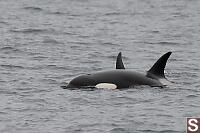
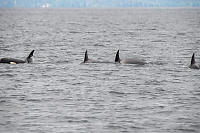
Of course none of that identification is done while the whales are
right in front of me. When the whales are up, I'm taking
photos, trying to either get good identification photos or
something resembling a good "action shot".

I have no idea what the whales are actually
doing, other than swimming. We didn't see any acrobatic
activity or long dives. The whales are probably just going
from one place to another and might be sleeping half their brains
while they swim to their destination.
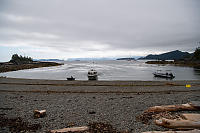
And not long after, we were at our
destination! The bay in front of Skedans is quite shallow so
you don't want to park your zodiak on a falling tide. We got
dropped off and we walked up the beach to shore.
Pre smallpox (before 1862), there was something like 30,000 Haida
living in the archipelago in many village sites. Skedans was
a moderately sized site with a variety of long houses and memorial
poles. Today there are still a few poles standing and a
number of house sites are still clearly visible. In Haida
tradition, poles are generally allowed to fall to the ground and
be recycled by nature, but sometimes some gardening is done to
slow the process down.
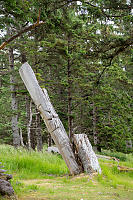

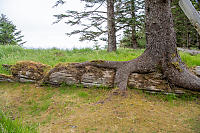
A watchmen guide shows around the site highlighting elements of
poles and telling stories of what it was like to live here.

Some of the poles here are Memorial poles -
built for people that were lost at sea. The generally have a
skulpin or dogfish at the bottom. Other poles are mortuary
poles where an important persons remains were boxed up.
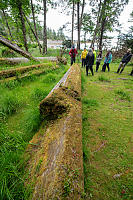
The homes come in a variety of sizes. If you look in the
pit, you can see different levels. The levels would be
seperated by hanging weaved cedar mats and families within the
building would have their own space on a level. Everything
was made of cedar and some of the cedar boards in the walls would
be taken on trips to make the next home easier to setup.
We walked around the site a little to take in the place.
Deer were quite easy to find. Deer are invasive here - they
were introduced between 1878 and 1925 and they are everywhere
now. One of their favorite food is cedar saplings and they
have basically prevented the next generation of cedar trees from
growing.
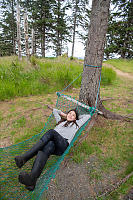
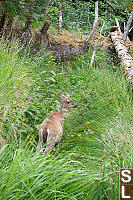

After our tour, we got back on the boat and headed off into the
ocean. I was surprised at our next destination - East
Limestone Island. I actually read about the Laskeek Bay
Conservation Society in advance of this trip - in another world a
week on an remote island doing science would be amazing, but with
a family of four it was unrealistic. I was quite surprised
we wound up on the island. Where the Zodiak brought us in
was a nice sheltered bay, but the actual goal was on the other
side of the island.




Abalone
is another sad Haida tale. Abalone was a big part of the diet
here but when there was an export market BC got silly and almost all
the Abalone was harvested. A moratorium on harvesting was put
in place to help the species recover and it appears to be
working. That said, Abalone was eaten for by the Haida for a
long time and many elders miss the taste. It can't be
harvested. There are tons of shells on the beach from where
birds leave them but you can't take the shells with you because it
could be a sign of harvesting. Hopefully the Abalone will
recover well enough that local use harvesting will be possible, but
if the Sea Otters do come back, that might be a setback for the
Abalone. No harvesting Sea Otters either.


As far as we can tell (the lead researcher did come in while we were
there), the Laskeek Bay Conversation Society setup here because this
is crucial habitat for Ancient Murrelet reproduction. In May
Murrelet eggs hatch hyper-precocial chicks that can walk to the
ocean a few days after hatching and grow up on the ocean. In
one magical night, hundreds of chicks come out of burrows and walk
down to the ocean to meet their calling parents, completely
overwhelming any predator like Raccoons. Every second year,
the population is surveyed while the chicks make the trip.
Amazing.
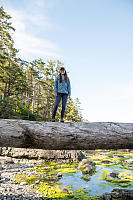
This time of the year the
researchers are out in boats looking at marine mammals.
We pulled into Thurston Harbour for the night and some people went
out of a paddle. Many of us were tired.
Tags: marine mammal(2), dolphin(2), whale(2), deer(1), grass(1), shell(1)
People: Claira(1)
From: John Harvey Photo > John's Overnight Page > Haida Gwaii > Skedans
From: John Harvey Photo > Haida Gwaii > Skedans
Last Modified Tuesday, September 5th, 2023 at 20:41:19 Edit
Copyright and Contact Information.

 Our First
Full Day on the water
Our First
Full Day on the water

 Our First
Full Day on the water
Our First
Full Day on the water













